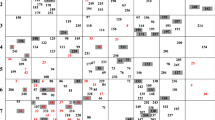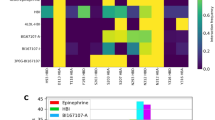Abstract
Experimental EC50s for 202 human β 3-AR agonists are used to develop classification models as a potential screening tool for a large library of target compounds before synthesis. A variable selection approach from random forests (VS-RF) is used to extract the structural information most relevant to the human β 3-AR activation properties of the collected data set. The obtained results indicate that the VS-RF method can be used for variable selection with smallest sets of non-redundant descriptors with highly predictive accuracy (Q ex% = 96% for the external prediction set). Thus, the proposed VS-RF models should be helpful for screening of potential human β 3-AR agonists before chemical synthesis in drug development.
Similar content being viewed by others
References
Stewart W, Van Rooyen J, Cundiff G, Abrams P, Herzog A, Corey R, Hunt T, Wein A (2003) Prevalence and burden of overactive bladder in the United States. World J Urol 20: 327–336. doi:10.1007/s00345-002-0301-4
Abrams P, Andersson K (2007) Muscarinic receptor antagonists for overactive bladder. BJU Int 100: 987–1006. doi:10.1111/j.1464-410X.2007.07205.x
Emorine L, Marullo S, Briend-Sutren M, Patey G, Tate K, Delavier-Klutchko C, Strosberg A (1989) Molecular characterization of the human β 3-adrenergic receptor. Science 245: 1118–1121. doi:10.1126/science.2570461
Yamaguchi O, Chapple C (2007) β 3-adrenoceptors in urinary bladder. Neurourol Urodyn 26: 752–756. doi:10.1002/nau.20420
Arch J, Ainsworth A, Cawthorne M, Piercy V, Sennitt M, Thody V, Wilson C, Wilson S (1984) Atypical β-adrenoceptor on brown adipocytes as target for anti-obesity drugs. Nature 309: 163–165. doi:10.1038/309163a0
Hu B, Jennings LL (2003) Orally bioavailable β 3-adrenergic receptor agonists as potential therapeutic agents for obesityand type-II diabetes. Prog Med Chem 41: 167–194. doi:10.1016/S0079-6468(02)41005-3
Uchida H, Shishido K, Nomiya M, Yamaguchi O (2005) Involvement of cyclic AMP-dependent and -independent mechanisms in the relaxation of rat detrusor muscle via β-adrenoceptors. Eur J Pharmacol 518: 195–202. doi:10.1016/j.ejphar.2005.06.029
de Souza C, Burkey B (2001) β 3-adrenoceptor agonists as anti-diabetic and anti-obesity drugs in humans. Curr Pharm Des 7: 1433–1449. doi:10.2174/1381612013397339
Mathvink RJ, Tolman JS, Chitty D, Candelore MR, Cascieri MA, Colwell LF, Deng L, Feeney WP, Forrest MJ, Hom GJ, MacIntyre DE, Miller RR, Stearns RA, Tota L, Wyvratt MJ, Fisher MH, Weber AE (2000) Discovery of a potent, orally bioavailable β 3 adrenergic receptor agonist, (R)−N-[4-[2-2-hydroxy-2-(3-pyridinyl)ethyl] amino] ethyl] phenyl]-4-[4-[4-(trifluoromethyl)phenyl]thiazol-2-yl]benzenesulfonamide. J Med Chem 43: 3832–3836. doi:10.1021/jm000286i
Uehling DE, Shearer BG, Donaldson KH, Chao EY, Deaton DN, Adkison KK, Brown KK, Cariello NF, Faison WL, Lancaster ME, Lin J, Hart R, Milliken TO, Paulik MA, Sherman BW, Sugg EE, Cowan C (2006) Biarylaniline phenethanolamines as potent and selective β 3 adrenergic receptor agonists. J Med Chem 49: 2758–2771. doi:10.1021/jm0509445
Shearer BG, Chao EY, Uehling DE, Deaton DN, Cowan C, Sherman BW, Milliken T, Faison W, Brown K, Adkison KK, Lee F (2007) Synthesis and evaluation of potent and selective β 3 adrenergic receptor agonists containing heterobiaryl carboxylic acids. Bioorg Med Chem Lett 17: 4670–4677. doi:10.1016/j.bmcl.2007.05.069
Imanishi M, Tomishima Y, Itou S, Hamashima H, Nakajima Y, Washizuka K, Sakurai M, Matsui S, Imamura E, Ueshima K, Yamamoto T, Yamamoto N, Ishikawa H, Nakano K, Unami N, Hamada K, Matsumura Y, Takamura F, Hattori K (2008) Discovery of a novel series of biphenyl benzoic acid derivatives as potent and selective human β 3-adrenergic receptor agonists with good oral bioavailability. Part I. J Med Chem 51: 1925–1944. doi:10.1021/jm701324c
Imanishi M, Itou S, Washizuka K, Hamashima H, Nakajima Y, Araki T, Tomishima Y, Sakurai M, Matsui S, Imamura E, Ueshima K, Yamamoto T, Yamamoto N, Ishikawa H, Nakano K, Unami N, Hamada K, Matsumura Y, Takamura F, Hattori K (2008) Discovery of a novel series of biphenyl benzoic acid derivatives as highly potent and selective human β3 adrenergic receptor agonists with good Oral bioavailability. Part II. J Med Chem 51: 4002–4020. doi:10.1021/jm8000345
Imanishi M, Nakajima Y, Tomishima Y, Hamashima H, Washizuka K, Sakurai M, Matsui S, Imamura E, Ueshima K, Yamamoto T, Yamamoto N, Ishikawa H, Nakano K, Unami N, Hamada K, Matsumura Y, Takamura F, Hattori K (2008) Discovery of a novel series of benzoic acid derivatives as potent and selective human β 3 adrenergic receptor agonists with good oral bioavailability. 3. Phenylethanolaminotetraline (PEAT) skeleton containing biphenyl or biphenyl ether moiety. J Med Chem 51: 4804–4822. doi:10.1021/jm800222k
Nakajima Y, Imanishi M, Itou S, Hamashima H, Tomishima Y, Washizuka K, Sakurai M, Matsui S, Imamura E, Ueshima K, Yamamoto T, Yamamoto N, Ishikawa H, Nakano K, Unami N, Hamada K, Hattori K (2008) Discovery of novel series of benzoic acid derivatives containing biphenyl ether moiety as potent and selective human β 3-adrenergic receptor agonists. Part IV. Bioorg Med Chem Lett 18: 5037–5040. doi:10.1016/j.bmcl.2008.08.009
Hattori K, Toda S, Imanishi M, Itou S, Nakajima Y, Washizuka K, Araki T, Hamashima H, Tomishima Y, Sakurai M, Matsui S, Imamura E, Ueshima K, Yamamoto T, Yamamoto N, Ishikawa H, Nakano K, Unami N, Hamada K, Matsumura Y, Takamura F (2009) Discovery of highly potent and selective biphenylacylsulfonamide-based β 3-adrenergic receptor agonists and evaluation of physical properties as potential overactive bladder therapies. Part 5. J Med Chem 52: 3063–3072. doi:10.1021/jm9000709
Hattori K, Orita M, Toda S, Imanishi M, Itou S, Nakajima Y, Tanabe D, Washizuka K, Araki T, Sakurai M, Matsui S, Imamura E, Ueshima K, Yamamoto T, Yamamoto N, Ishikawa H, Nakano K, Unami N, Hamada K, Matsumura Y, Takamura F (2009) Discovery of highly potent and selective biphenylacylsulfonamide-based β 3-adrenergic receptor agonists and molecular modeling based on the solved X-ray structure of the β 2-adrenergic receptor. Part 6. Bioorg Med Chem Lett 19: 4679–4683. doi:10.1016/j.bmcl.2009.06.083
Sun X, Li Y, Liu X, Ding J, Wang Y, Shen H, Chang Y (2008) Classification of bioaccumulative and non-bioaccumulative chemicals using statistical learning approaches. Mol Divers 12: 157–169. doi:10.1007/s11030-008-9092-x
Wang Y, Li Y, Yang S, Yang L (2005) Classification of substrates and inhibitors of P-glycoprotein using unsupervised machine learning approach. J Chem Inf Model 45: 750–757. doi:10.1021/ci050041k
Li Y, Wang Y, Ding J, Wang Y, Chang Y, Zhang S (2009) In silico prediction of androgenic and nonandrogenic compounds using random forest. QSAR Comb Sci 28: 396–405. doi:10.1002/qsar.200810100
Hao M, Li Y, Wang Y, Zhang S (2010) Prediction of PKCθ inhibitory activity using the random forest algorithm. Int J Mol Sci 11: 3413–3433. doi:10.3390/ijms11093413
Sun H (2005) A naive Bayes classifier for prediction of multidrug resistance reversal activity on the basis of atom typing. J Med Chem 48: 4031–4039. doi:10.1021/jm050180t
Telvekar V, Patel D, Jadhav N, Mishra S (2010) Three-dimensional QSAR and pharmacophore mapping of biphenyl benzoic acid derivatives as selective human β 3-adrenergic receptor agonists. Med Chem Res 19: 1174–1190. doi:10.1007/s00044-009-9261-1
Richard D, David E, Jeffrey D (1988) Comparative molecular field analysis (CoMFA). 1. Effect of shape on binding of steroids to carrier proteins. J Am Chem Soc 110: 5959–5967. doi:10.1021/ja00226a005
Klebe G, Abraham U, Mietzner T (1994) Molecular similarity indices in a comparative analysis (CoMSIA) of drug molecules to correlate and predict their biological activity. J Med Chem 37: 4130–4146. doi:10.1021/jm00050a010
DRAGON, rel. 5.2 for Windows (2004) Talete srl, Milano, Italy
Kauffman GW, Jurs PC (2001) QSAR and k-nearest neighbor classification analysis of selective cyclooxygenase-2 inhibitors using topologically-based numerical descriptors. J Chem Inf Comput Sci 41: 1553–1560. doi:10.1021/Ci010073h
Svetnik V, Liaw A, Tong C, Culberson JC, Sheridan RP, Feuston BP (2003) Random forest: a classification and regression tool for compound classification and QSAR modeling. J Chem Inf Comput Sci 43: 1947–1958. doi:10.1021/ci034160g
Gao H (2001) Application of BCUT metrics and genetic algorithm in binary QSAR analysis. J Chem Inf Comput Sci 41: 402–407. doi:10.1021/Ci000306p
Roy K, Mitra I, Saha A (2009) Molecular shape analysis of antioxidant and squalene synthase inhibitory activities of aromatic tetrahydro-1,4-oxazine derivatives. Chem Biol Drug Des 74: 507–516. doi:10.1111/j.1747-0285.2009.00888.x
Díaz-Uriarte R, Alvarezde Andrés S (2006) Gene selection and classification of microarray data using random forest. BMC bioinformatics 7: 3. doi:10.1186/1471-2105-7-3
ISIS Draw 2.3, MDL Information Systems, Inc
Hemmateenejad B, Yazdani M (2009) QSPR models for half-wave reduction potential of steroids: a comparative study between feature selection and feature extraction from subsets of or entire set of descriptors. Anal Chim Acta 634: 27–35. doi:10.1016/j.aca.2008.11.062
Golbraikh A, Tropsha A (2002) Predictive QSAR modeling based on diversity sampling of experimental datasets for the training and test set selection. J Comput Aided Mol Des 16: 357–369. doi:10.1023/A:1020869118689
Breiman L (2001) Random forests. Mach Learn 45: 5–32. doi:10.1023/A:1010933404324
randomForest: Breiman and Cutler’s random forests for classification and regression. http://cran.r-project.org/web/packages/randomForest/index.html. Accessed on 27 May 2011
varSelRF: Variable selection using random forests. http://cran.r-project.org/web/packages/varSelRF/index.html. Accessed on 27 May 2011
Guyon I, Weston J, Barnhill S, Vapnik V (2002) Gene selection for cancer classification using support vector machines. Mach Learn 46: 389–422. doi:10.1023/A:1012487302797
kernlab: Kernel-based machine learning lab. http://cran.r-project.org/web/packages/kernlab/index.html. Accessed on 27 May 2011
MASS: Main package of venables and Ripley’s MASS. http://cran.r-project.org/web/packages/MASS/index.html. Accessed on 27 May 2011
Matthews BW (1975) Comparison of the predicted and observed secondary structure of T4 phage lysozyme. Biochim Biophys Acta 405: 442–451. doi:10.1016/0005-2795(75)90109-9
Ren Y, Liu H, Yao X, Liu M (2007) Prediction of ozone tropospheric degradation rate constants by projection pursuit regression. Anal Chim Acta 589: 150–158. doi:10.1016/j.aca.2007.02.058
Eriksson L, Jaworska J, Worth A, Cronin M, McDowell R, Gramatica P (2003) Methods for reliability and uncertainty assessment and for applicability evaluations of classification- and regression-based QSARs. Environ Health Perspect 111: 1361–1375. doi:10.1289/ehp.5758
caret: Classification and regression training. http://cran.r-project.org/web/packages/caret/index.html. Accessed on 27 May 2011
Ren Y, Liu H, Xue C, Yao X, Liu M, Fan B (2006) Classification study of skin sensitizers based on support vector machine and linear discriminant analysis. Anal Chim Acta 572: 272–282. doi:10.1016/j.aca.2006.05.027
Burden F (1997) A chemically intuitive molecular index based on the eigenvalues of a modified adjacency matrix. Quant Struct Act Relatsh 16: 309–314. doi:10.1002/qsar.19970160406
Mercader A, Duchowicz P, Fernández F, Castro E, Bennardi D, Autino J, Romanelli G (2008) QSAR prediction of inhibition of aldose reductase for flavonoids. Bioorg Med Chem 16: 7470–7476. doi:10.1016/j.bmc.2008.06.004
Stanton DT (1999) Evaluation and use of BCUT descriptors in QSAR and QSPR studies. J Chem Inf Comput Sci 39: 11–20. doi:10.1021/ci980102x
Pirard B, Pickett S (2000) Classification of kinase inhibitors using BCUT descriptors. J Chem Inf Comput Sci 40: 1431–1440. doi:10.1021/ci000386x
Ford M, Pitt W, Whitley D (2004) Selecting compounds for focused screening using linear discriminant analysis and artificial neural networks. J Mol Graph Model 22: 467–472. doi:10.1016/j.jmgm.2004.03.006
Author information
Authors and Affiliations
Corresponding author
Electronic Supplementary Material
The Below is the Electronic Supplementary Material.
Rights and permissions
About this article
Cite this article
Hao, M., Li, Y., Wang, Y. et al. A classification study of human β 3-adrenergic receptor agonists using BCUT descriptors. Mol Divers 15, 877–887 (2011). https://doi.org/10.1007/s11030-011-9321-6
Received:
Accepted:
Published:
Issue Date:
DOI: https://doi.org/10.1007/s11030-011-9321-6




